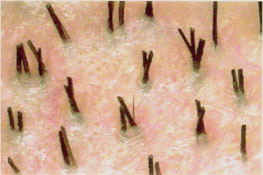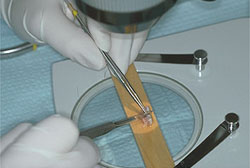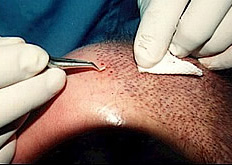ALOPECIA RESEARCH
Trends in Human Hair Growth and Alopecia Research Edited by Van Nesle, J.M. Lachapelle and J.L. Antoine : Occupational Dermatology Unit, Catholic University of Louvain,
Bruxelles, Belgium. ISBN 0-7462-01 17-6
Topical minoxidil used before and after hair transplantation surgery : Bouhanna : Hair Department Hôpital Saint-Louis, Paris, France
ABSTRACT
A 2% topical minoxidil solution was applied on the recipient bald scalp of sixteen patients aged 25 to 52 years with Hamilton classification of androgenetic alopecia from III to IV. Therapy began 4 weeks before surgery, then stopped during 3 weeks and started again for 3 months. 4 mm grafts were inserted into 3.5 mm recipient holes. A macrophotographic follow-up was done for 3 months on four grafts near a tattooed located area. On about 71% of the 64 grafts, partial or total hair is still growing without the shedding that usually occurs 2-4 weeks after transplantation. Topical minoxidil seems to be an adjunct for a better evolution of grafts after hair transplant surgery.
INTRODUCTION
Since 1974 in our own practice we have used the punch graft technique 1-2 for the treatment of androgenetic alopecia 3-4. Until 1981 we used a macrophotographic study and the phototrichogram technique for the follow-up of grafts and flaps5. We have carried out 64 of 4 mm punch grafts on 16 individuals. Patients were treated with a 2% solution of topical minoxidil. Therapy began
1 month before hair transplantation and started again 3 weeks after transplantation for 3 months. A macrophotographic follow-up of located grafts was done for 3 months. Several patients demonstrated hair growth in the grafts without the shedding that usually occurs 2 to 4 weeks after surgery (Figure 1). Hairs are still growing, whereas regrowth begins 3-5 months after surgery in untreated patients. Contrary to the opinion of many authors6 we have found that the postoperative shedding phase which occurs in the grafts about 3 weeks after transplantation is an anagen defluvium and not a telogen effluvium (Figure 2).
MATERIAL AND METHODS
Sixteen healthy male patients aged 25-52 years with Hamilton classification of androgenetic alopecia from HI to IV, who were undergoing a hair transplant procedure, participated in this open controlled study. Each patient was given a complete physical and biological examination. Beginning 1 month before surgery, each subject applied minoxidil 2%, 1 ml twice daily on the recipient area. This local treatment was stopped for 3 weeks and started again for 3 months. Sixty-four 4 mm punch grafts were harvested with a 4 mm power punch. The occipital area was infiltrated with a solution of 1% lidocaine and epinephrine. Saline solution was administered to increase tissue turgor. Twenty to 30 min elapsed between the harvesting and cleaning of the grafts and their insertion into the recipient area. During this period the grafts were placed in a saline solution at room temperature. All 4 mm grafts were transplanted into a 3.5 mm hole at an angle of about 60 °.
A macrophotographic follow-up was done for 3 months on four grafts near a tattooed located area for each of the 16 individuals (Figure 3).
The macrophotographic equipment is an Olympus OM2 with a 50 mm macro-objective, a telescopic tube, a lateral flash Olympus T32 (Figure 4) and a grid of our own fabrication screwed on the objective which outlines 0.25 cm2 areas7›3. The grid is applied on each located graft to be studied and the central 0.25 cm2 area is photographed. Three successive macrophotographs are taken on the grafted area and on each located graft on Day 0 and Day 90 (Figure 5). This macrophotographic technique enables objective assessment of hair loss and hair regrowth of each graft.
Results
We carried out 64 punch grafts of 4 mm on 16 healthy male individuals aged 25-52 years with a 2% minoxidil topical treatment. Hairs on grafts were counted at Day O, Day 30 and Day 90.
DISCUSSION
A 2% topical minoxidil solution used in preoperative and postoperative transplantation sessions seems to be effective on postoperative shedding and regrowth of hair on transplants. Contrary to many authors the postoperative shedding phase is not a telogen ef?uvium but an anagen defluvium. It is an explanation of the shedding hair which occurs 2-4 weeks after hair transplantation and the regrowth which begins 3-5 months after surgery in untreated patients. We have not found any report of immediate hair growth after hair transplantation without a prior shedding of hair.
It is of considerable interest that, 30 days after a hair transplant session, hairs are still growing on about 71% of grafts but hair loss was less than 50% in about 3 1% of grafts (Table 1). Three months after transplantation hair loss was less than 50% on about 84% of grafts (Table 2). On the grafts some thick hairs 2-4 cm in length form the primarily growing hair, and some fine and short hairs form the new growing hair. Topical minoxidil seems to allow an unceasing anagen stage and therefore to be an important adjunct for better evolution of grafts after hair transplantation (Figure 6).
Table 1 Evaluation of the hair loss on grafts at Day 30
|
Rate of hair loss (%) |
Number of grafts |
Rate of grafts (%) |
|
100 |
18 |
28.12 |
|
75-99 |
13 |
20.34 |
|
50-75 |
13 |
20.34 |
|
25-50 |
11 |
17.18 |
|
0-25 |
9 |
14.09 |
Table 2 Evaluation of the hair loss on grafts at Day 90
|
Rate of hair loss (%) |
Number of grafts |
Rate of grafts (%) |
|
100 |
2 |
3.12 |
|
75-99 |
4 |
6.25 |
|
50-75 |
4 |
6.25 |
|
25-50 |
18 |
28.12 |
|
0-25 |
36 |
56.25 |
REFERENCES
1- Okuda S. The study of clinical experiments and hair transplantation. Jpn JDermatol Urol, October: 537, 1939
- 2- Orentreich N. Autografts in alopecias and other related dermatologie conditions. Ann NY Acad Sci, 83, 403, 1959
- 3- Bouhanna P. Le cuir chevelu. Les alopécies définitives et leurs traitements. Thesis, Paris, 1976
- 4- Bouhanna P, Nataf J. A propos des transplantations du cuir chevelu. Critiques et propositions. Rev Chir Esth, 7, 17-23, 1976
- 5- Bouhanna P. The advantage of phototrichogram in hair surgery. The international advanced hair replacement symposium. Birmingham, Alabama, 3-4 February, 1982
- 6- Kassimir JJ. Use of topical minoxidil as a possible adjunct to hair transplant surgery. J Am Acad Derm, 16, 685-687, 1987
- 7- Bouhanna P. The phototrichogram. A technique for the objective evaluation of the diagnosis and course of diffuse alopecias. In Hair and Esthetic Medicine (Montagna W, cd.), Rome: Salus ed, 1983
- 8- Bouhanna P. The phototrichogram: an objective technique used in hair replacement surgery evaluation. In Hair Transplantation, 2nd edn (Unger PW, Nordström RE, eds). New York: Marcel Dekker, 1987
- 9- Bouhanna P. Topical minoxidil used in hair surgery. The international congress for hair replacement surgery. Los Angeles, California, 21-24 May, 1987







